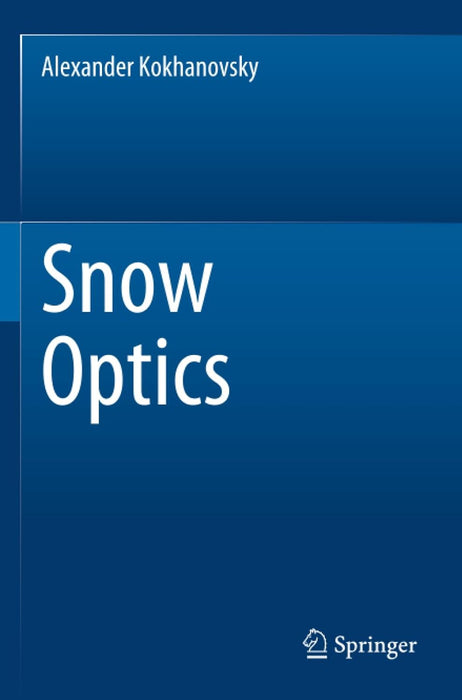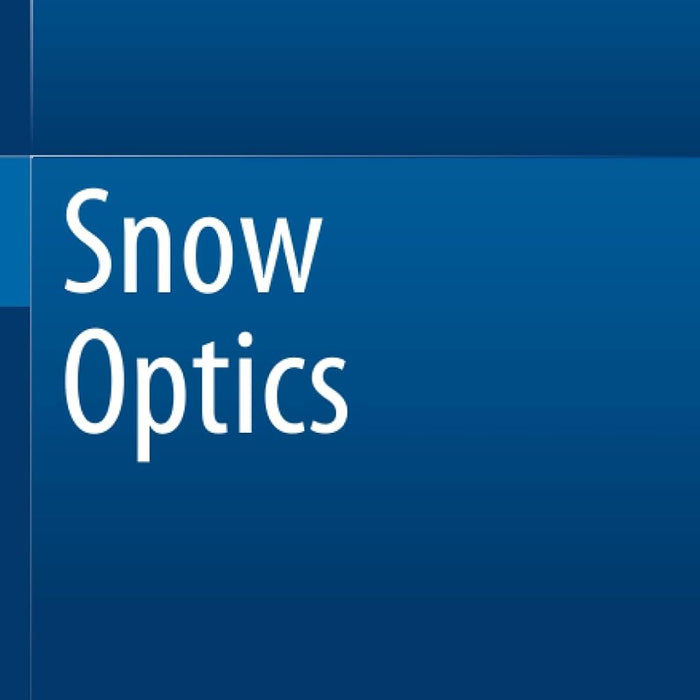Snow Optics by Alexander Kokhanovsky (Author)
- Publisher: PHYSICS
- Availability: In Stock
- SKU: 49479
- Number of Pages: 161
Rs.450.00
Rs.600.00
Tags: Alexander Kokhanovsky , atmospheric optics , best books , Best Price , best prices , best shop , BNB , bookshop , bookshop online , bookshopPakistan , buy online books , good books , good booksonline , light propagation in snow , light scattering in snow , online books store , Online Bookshop , Online Bookshop Pakistan , online shopping , Online Shopping Pakistan , OnlineShoppingPakistan , optical characteristics of snow , optical measurements in snow , optical models in snow , optical properties of ice , optical properties of snow , PakistanBookshop , PakistanOnlineShopping , polarimetric snow studies , price cut , price-friendly Comprehensive , radiative transfer in snow , ReasonablePrice , reduced price , remote sensing of snow , Shopping , ShopSmartPakistan , snow albedo , snow and climate , snow and environment , snow and light interaction , snow and meteorology , snow and solar radiation , snow climatology , snow composition , snow cover , snow crystal structure , snow measurement techniques , snow measurements for climate change , snow monitoring , Snow Optics , snow optics for remote sensing , snow particles , snow physics , snow reflectance , snow scattering models , snow science , snow spectral reflectance , snow surface properties , snow transmission
Snow Optics by Alexander Kokhanovsky provides a detailed examination of the optical properties of snow, focusing on the interaction between light and snow particles. The book explores the physical principles of light scattering, absorption, and transmission in snow-covered environments, offering an interdisciplinary perspective that integrates optical physics with environmental and atmospheric science. Kokhanovsky delves into the modeling of snow optical properties and their applications in fields such as climate research, remote sensing, and glaciology. This comprehensive text highlights the importance of snow optics in understanding the Earth’s energy balance, climate change, and the behavior of light in polar and high-altitude environments. The book combines theoretical discussions with practical applications, making it an essential resource for researchers, scientists, and students in the fields of environmental science, atmospheric physics, and optical engineering.
Key Points:
-
Light-Snow Interaction: The book provides a comprehensive explanation of how light interacts with snow particles, focusing on scattering, absorption, and transmission mechanisms that govern snow's optical properties.
-
Radiative Transfer in Snow: It discusses the principles of radiative transfer as applied to snow, explaining how light propagates through snow and its effect on energy absorption, reflection, and transmission in snow-covered areas.
-
Snow-Albedo Effect: The text explores the role of snow albedo (reflectivity) in climate systems, emphasizing its impact on the Earth’s energy balance and its contribution to the global warming effect.
-
Remote Sensing Applications: The book outlines how the optical properties of snow are critical in remote sensing technologies, including the use of satellite imagery for monitoring snow cover, glacial dynamics, and environmental changes.
-
Snow Particle Shape and Size: Detailed analysis is provided on how the size, shape, and structure of snow crystals affect the optical properties of snow, influencing both theoretical models and practical observations.
-
Modeling Snow Optics: The text covers various models used to describe and predict snow's optical behavior, including scattering models, radiative transfer equations, and their applications in snowpack studies.
-
Impact on Climate Studies: Kokhanovsky explains how understanding snow optics is crucial for climate models, particularly in high-latitude regions and mountainous environments, where snow plays a significant role in regional and global climate dynamics.
-
Snow and Light Pollution: The book examines how snow-covered landscapes contribute to light pollution, especially in polar regions, and its effects on human health and the natural environment.
-
Optical Properties in Different Environments: A detailed discussion on how the optical properties of snow vary with different environmental conditions, including altitude, geographic location, and seasonal changes.
-
Applications in Glaciology: The book explores the importance of snow optics in studying glaciers, including its role in understanding snowmelt, ice sheet dynamics, and glacial retreat, which are crucial in assessing the impacts of climate change.
Conclusion:
Snow Optics by Alexander Kokhanovsky is an essential resource for understanding the complex optical properties of snow and their implications for climate science, remote sensing, and environmental research. By blending theoretical physics with practical applications, this book provides valuable insights into how light interacts with snow, contributing to our understanding of snow's role in the Earth's energy system and the broader effects on global climate change. It is a must-read for anyone involved in the study of snow, glaciology, atmospheric sciences, and environmental monitoring.
════ ⋆★⋆ ═══
Writer ✤ Alexander Kokhanovsky (Author)

























